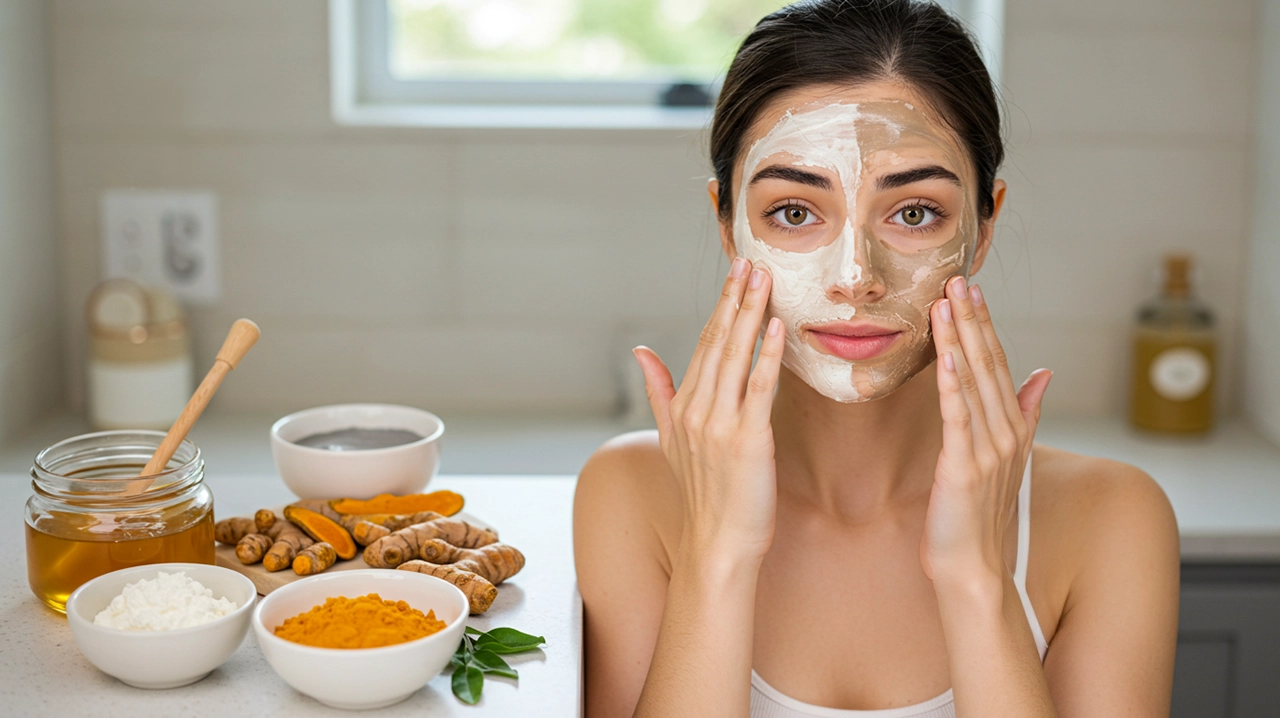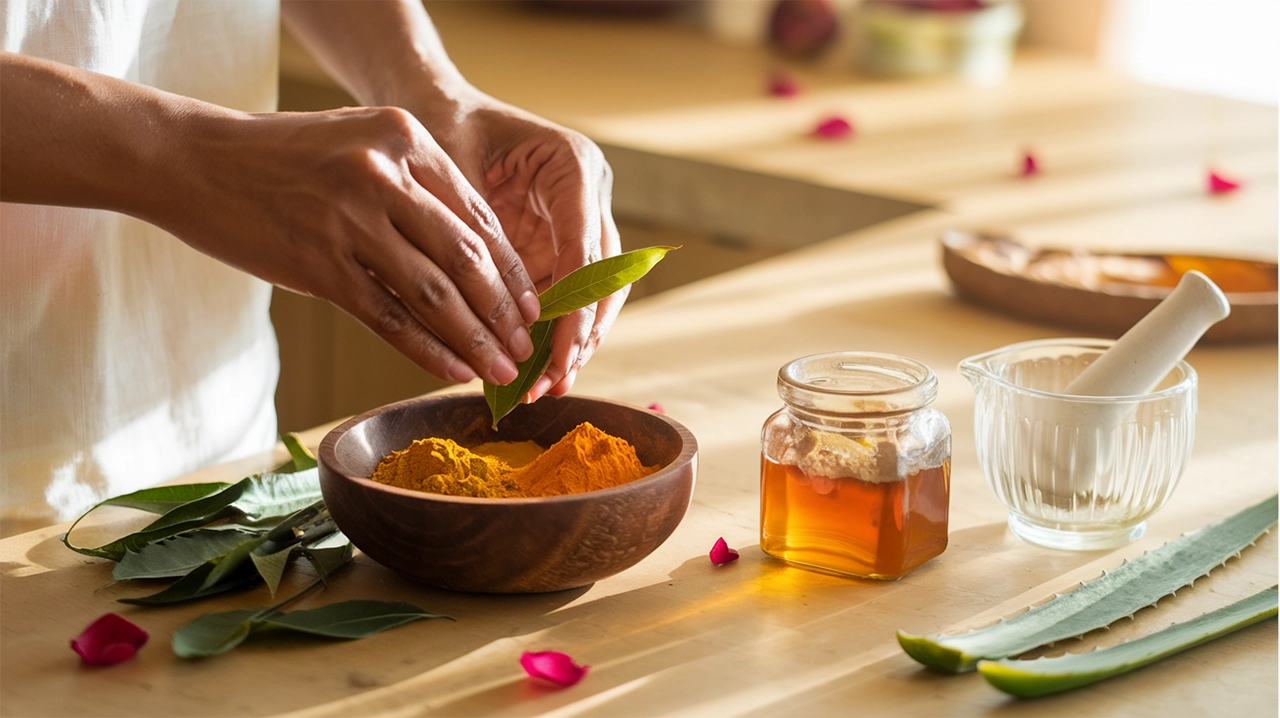

Ayurvedic homemade face mask for acne treatment
Are you tired of battling stubborn acne that just won’t seem to go away? 😫 You’ve probably tried countless over-the-counter products, but have you considered the ancient wisdom of Ayurveda? This time-tested holistic approach might just be the solution you’ve been searching for!
Imagine having the power to create your own natural, effective face masks right in your kitchen. 🌿 With Ayurvedic principles and ingredients, you can tackle acne at its root while nourishing your skin. No more harsh chemicals or expensive treatments – just pure, wholesome goodness that your skin will thank you for.
In this blog post, we’ll dive into the world of Ayurvedic homemade face masks for acne treatment. You’ll discover the essential principles behind this ancient practice, learn about powerful acne-fighting ingredients, and get your hands on some easy-to-follow DIY recipes. We’ll also cover proper application techniques and complementary Ayurvedic practices to help you achieve that clear, glowing complexion you’ve always dreamed of. Ready to revolutionize your skincare routine? Let’s get started! 🌟
Understanding Ayurvedic Principles for Acne Treatment
Balancing doshas for clear skin
In Ayurveda, your skin health is directly linked to the balance of your doshas – Vata, Pitta, and Kapha. Each dosha influences your skin differently:
| Dosha | Skin Characteristics | Acne Tendency |
|---|---|---|
| Vata | Dry, thin, sensitive | Occasional |
| Pitta | Oily, sensitive, prone to inflammation | Frequent |
| Kapha | Oily, thick, congested | Persistent |
To achieve clear skin, you need to balance these doshas. For instance, if you have Pitta-type acne, cooling ingredients like neem or aloe vera can help. For Kapha-type acne, use warming herbs like ginger or turmeric.
Identifying acne-causing factors in Ayurveda
Ayurveda recognizes several factors that contribute to acne:
Poor digestion (Ama)
Hormonal imbalances
Stress
Improper diet
Lack of sleep
Understanding these factors helps you address the root cause of your acne, not just the symptoms. For example, improving your digestion through proper food combinations can significantly reduce acne occurrence.
Benefits of natural ingredients in face masks
Natural ingredients offer numerous benefits for acne-prone skin:
Anti-inflammatory properties
Antibacterial action
Gentle exfoliation
Balancing oil production
Nourishing the skin
Ingredients like turmeric, neem, and sandalwood not only fight acne but also improve overall skin health. These natural remedies work in harmony with your body, unlike harsh chemical treatments that may cause side effects.
Now that you understand the Ayurvedic principles behind acne treatment, let’s explore the essential Ayurvedic ingredients you can use in your face masks.

Neem: Nature’s antiseptic
You’ll find neem to be a powerhouse ingredient in Ayurvedic acne treatments. Its natural antiseptic properties make it highly effective against acne-causing bacteria. Neem also helps reduce inflammation and redness associated with breakouts.
Turmeric: Anti-inflammatory powerhouse
Turmeric is your go-to ingredient for combating inflammation. Its active compound, curcumin, not only reduces swelling but also helps fade acne scars. When used in face masks, turmeric can give your skin a healthy glow while fighting acne.
Sandalwood: Cooling and soothing properties
For those with sensitive, acne-prone skin, sandalwood is a game-changer. Its cooling effect helps calm irritated skin, while its astringent properties tighten pores and control excess oil production.
Honey: Natural moisturizer and antibacterial agent
Honey is a versatile ingredient that offers multiple benefits for acne-prone skin. It’s a natural humectant, drawing moisture to your skin without clogging pores. Additionally, its antibacterial properties help fight acne-causing bacteria.
Here’s a quick comparison of these essential Ayurvedic ingredients:
| Ingredient | Main Benefit | Skin Type Suitability |
|---|---|---|
| Neem | Antiseptic | All, especially oily |
| Turmeric | Anti-inflammatory | All types |
| Sandalwood | Cooling and pore-tightening | Sensitive and oily |
| Honey | Moisturizing and antibacterial | All types |
By incorporating these powerful Ayurvedic ingredients into your face masks, you’re harnessing nature’s potent acne-fighting properties. Remember to patch test new ingredients to ensure they suit your skin. Next, we’ll explore some DIY Ayurvedic face mask recipes that combine these ingredients for maximum effectiveness.

Neem and turmeric mask for oily skin
You can harness the power of neem and turmeric to combat oily, acne-prone skin. This potent combination offers antibacterial and anti-inflammatory properties that help balance sebum production and soothe irritated skin.
Recipe:
1 tablespoon neem powder
1/2 teaspoon turmeric powder
2 tablespoons plain yogurt
Mix the ingredients to form a smooth paste. Apply evenly to your face, avoiding the eye area. Leave on for 15-20 minutes before rinsing with lukewarm water.
Sandalwood and rose water mask for sensitive skin
For those with sensitive skin, this gentle yet effective mask combines the soothing properties of sandalwood with the balancing effects of rose water.
Recipe:
2 tablespoons sandalwood powder
1-2 tablespoons rose water
Blend the ingredients to create a thin paste. Apply a thin layer to your face and neck. Allow it to dry for 10-15 minutes, then rinse off with cool water.
Multani mitti and honey mask for combination skin
This mask addresses the unique needs of combination skin by absorbing excess oil while maintaining hydration.
Recipe:
2 tablespoons multani mitti (Fuller’s earth)
1 tablespoon raw honey
1-2 teaspoons water (as needed)
Mix the ingredients to form a smooth paste. Apply to your face, focusing on oily areas. Leave on for 10-15 minutes before washing off with lukewarm water.
Aloe vera and tulsi mask for inflamed acne
Aloe vera and tulsi work together to soothe inflammation and promote healing of acne-prone skin.
Recipe:
2 tablespoons fresh aloe vera gel
1 tablespoon tulsi (holy basil) powder
1 teaspoon honey
Combine all ingredients thoroughly. Apply the mixture to affected areas or your entire face. Rinse off after 15-20 minutes with cool water.
| Mask Type | Main Benefits | Frequency of Use |
|---|---|---|
| Neem & Turmeric | Antibacterial, oil control | 1-2 times per week |
| Sandalwood & Rose Water | Soothing, balancing | 2-3 times per week |
| Multani Mitti & Honey | Oil absorption, hydration | 1-2 times per week |
| Aloe Vera & Tulsi | Anti-inflammatory, healing | 2-3 times per week |
With these DIY Ayurvedic face mask recipes, you can customize your skincare routine to address your specific acne concerns. Remember to patch test before applying any new mask to your face. Now, let’s explore the proper application techniques to maximize the benefits of these masks.
Preparing your skin for the mask
Before applying your Ayurvedic face mask, it’s essential to prepare your skin properly. Start by cleansing your face with a gentle, natural cleanser to remove any dirt, oil, or makeup. Next, open your pores by steaming your face for 5-10 minutes or applying a warm, damp towel. This step enhances the mask’s effectiveness by allowing the ingredients to penetrate deeper into your skin.
Applying the mask effectively
To apply the mask, use clean fingers or a soft brush. Gently spread an even layer over your face, avoiding the delicate eye area. Pay special attention to acne-prone areas, but ensure you cover your entire face for balanced treatment. Apply the mask in upward, circular motions to promote circulation and maximize absorption.
Recommended duration for different skin types
The ideal duration for keeping the mask on varies depending on your skin type:
| Skin Type | Recommended Duration |
|---|---|
| Oily | 15-20 minutes |
| Normal | 10-15 minutes |
| Dry | 5-10 minutes |
| Sensitive | 3-5 minutes |
Gentle removal methods
When it’s time to remove the mask, use these gentle techniques:
Lukewarm water rinse: Splash your face with lukewarm water, gently massaging in circular motions.
Damp cloth method: Use a soft, damp cloth to wipe away the mask in gentle, upward strokes.
Natural sponge technique: Employ a natural sponge soaked in warm water to remove the mask delicately.
After removal, pat your face dry with a clean towel and follow up with a light, non-comedogenic moisturizer to lock in the benefits of your Ayurvedic treatment.

Dietary adjustments to support clear skin
You can enhance the effectiveness of your Ayurvedic face mask by making specific dietary changes. Focus on incorporating foods that balance your dosha and promote skin health. Here’s a quick guide:
| Dosha | Foods to Favor | Foods to Avoid |
|---|---|---|
| Vata | Warm, cooked foods | Cold, raw foods |
| Pitta | Cool, sweet fruits | Spicy, oily foods |
| Kapha | Light, dry foods | Heavy, oily foods |
Include plenty of leafy greens, antioxidant-rich berries, and hydrating fruits in your diet. These nutrient-dense foods support skin repair and reduce inflammation.
Herbal teas for internal cleansing
Complement your acne treatment with Ayurvedic herbal teas that purify your system from within. Try these beneficial blends:
Neem tea: Known for its antibacterial properties
Tulsi (Holy Basil) tea: Helps balance hormones
Cumin, coriander, and fennel tea: Aids digestion and detoxification
Drink these teas regularly to support your skin’s natural healing process.
Yoga poses for hormonal balance
Certain yoga poses can help balance your hormones and reduce acne breakouts. Incorporate these asanas into your routine:
Matsyasana (Fish Pose)
Sarvangasana (Shoulder Stand)
Bhujangasana (Cobra Pose)
Halasana (Plow Pose)
Practice these poses for 10-15 minutes daily to see improvements in your skin health.
Stress-reduction techniques for skin health
Stress can exacerbate acne, so it’s crucial to manage it effectively. Try these Ayurvedic stress-reduction techniques:
Meditation: Practice mindfulness for 10-15 minutes daily
Pranayama: Focus on deep breathing exercises like Nadi Shodhana
Abhyanga: Perform self-massage with warm oil before bathing
By incorporating these complementary practices, you’ll create a holistic approach to acne management that works in harmony with your Ayurvedic face mask treatments.
By incorporating Ayurvedic principles and ingredients into your skincare routine, you can effectively combat acne and promote overall skin health. The DIY face mask recipes provided offer natural, gentle alternatives to harsh chemical treatments, allowing you to harness the power of ancient wisdom in your modern skincare regimen.
Remember, consistency is key when it comes to Ayurvedic acne treatment. Combine these face masks with proper application techniques and complementary Ayurvedic practices for optimal results. As you embark on your journey towards clearer, healthier skin, be patient and listen to your body’s needs. With time and dedication, you’ll discover the perfect Ayurvedic approach to unveil your skin’s natural radiance.

Skincare researcher and content creator dedicated to helping readers achieve healthy, glowing skin. With a deep understanding of skincare ingredients, routines, and industry trends, she combines scientific insights with practical tips to educate and empower her audience.
Your Ultimate Guide to Healthy, Glowing Skin – Expert Tips, Honest Reviews & Skincare Secrets!
Sign up our newsletter to get update tips, honest reviews & skincare secrets!